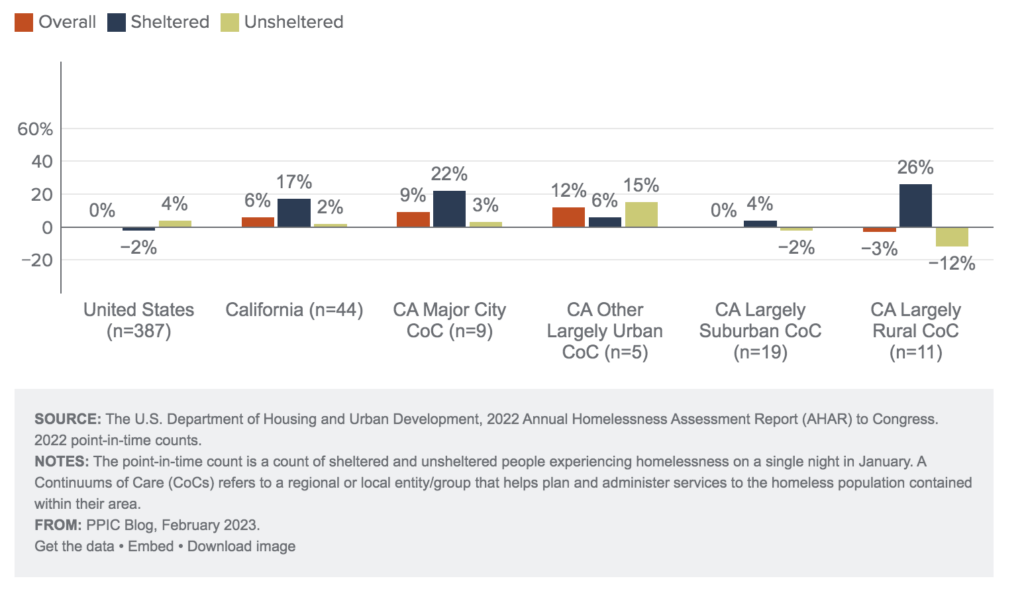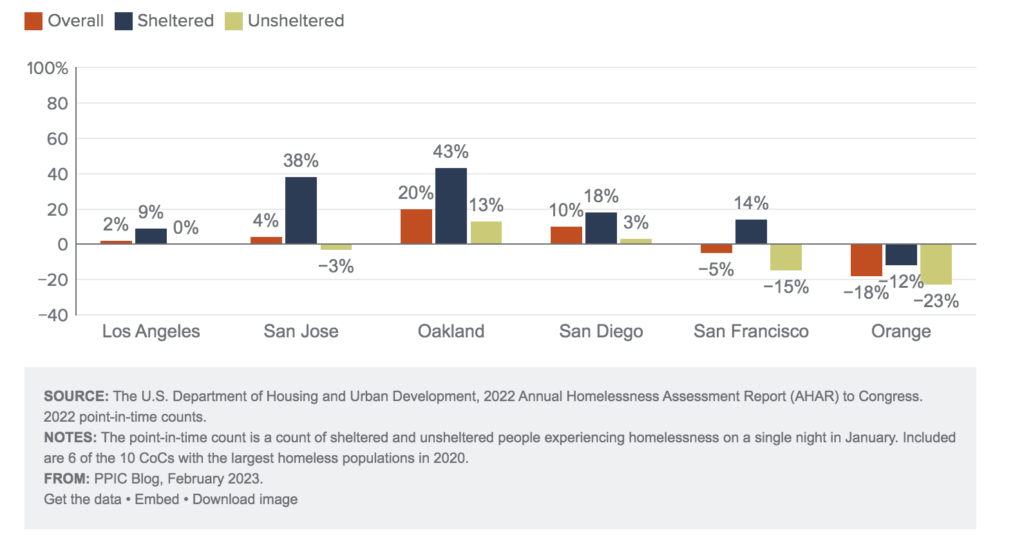
Homelessness continues to grow in California: nationally, California has topped the list for the state with the largest homeless population for more than a decade. As of 2022, 30% of all people in the United States experiencing homelessness resided in California, including half of all unsheltered people (115,491 in California; 233,832 in the US).
Every January, the federal government conducts a “Point in Time” (PIT) count of the nation’s homeless population. While imperfect, this count serves as one of the few concrete measures of the homelessness crisis. Findings for this January’s PIT count will not be available until later this year, but we have the results of the January 2022 PIT count. The 2022 count, released last December, offers the first complete data since the start of the coronavirus pandemic in March of 2020, as many counts were put on pause for health and safety reasons.
Changes from 2020 to 2022 reflect a new snapshot of California’s homeless population. The pandemic caused federal and state-level responses to protect people experiencing homelessness, including offering hotel rooms as temporary housing, moratoriums on evictions, and expanded housing supports.
Since 2020, California’s overall homeless population has increased about 6%, compared to just 0.4% in the rest of the country. A 17% increase in the homeless but sheltered population accounts for almost all of California’s change, while the more visible unsheltered population increased 2%. The rest of the country’s unsheltered population grew faster than California’s (4%), while its sheltered population actually shrank (-2%).
States are divided into Continuums of Care (CoCs) that help plan and administer services to the homeless population. California has by far the most COCs of any state with 44; Florida is a distant second with 27. CoCs are also categorized for the geographic area they serve: urban, suburban, or rural. Across California, the sheltered homeless in major cities (22%) and in rural areas (26%) saw the largest growth. However, the homeless population in cities is more than ten times the rural homeless population (38,000 compared to 3,300). Furthermore, some categories saw small decreases—the rural and suburban unsheltered homeless populations fell by 12% and 3%, respectively.
California sees increases in homeless population, mainly in urban areas
Change in the number of people experiencing homelessness, 2020-2022 (%)

The largest cities and CoCs in the state account for California’s six largest homeless populations, or 64% of the state’s homeless population. The Los Angeles CoC was largest at 38%, with San Jose (5.8%), Oakland (5.7%), Sacramento (5.4%), San Diego (4.9%) and San Francisco (4.5%) far behind.
2022 counts show that homeless populations declined in San Francisco and Orange County
Change in the number of people experiencing homelessness, 2020-2022 (%)

Although CoC homeless populations vary greatly in size, trends over time are similar. The overall number of people experiencing homelessness has increased everywhere outside of the San Francisco and Orange County CoCs. Sheltered populations have also increased everywhere but the Orange CoC, while unsheltered population changes have been more mixed.
Pandemic homeless programs have begun to unwind and the substantial federal funding efforts around COVID are expiring; the disappearance of these programs and funds may alter the options available to people experiencing homelessness in California. The state is taking steps to point legislation toward addressing issues around homelessness—including setting up CARE courts for mental health support— while bipartisan pressure is growing to audit how recent funds were spent. As California works to adapt to changes after the pandemic, PPIC will continue to monitor and analyze trends affecting homeless populations.